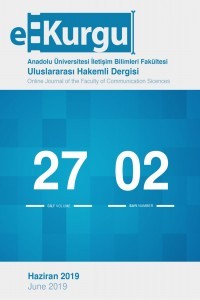Dünyada Bilim İletişiminin Gelişimi ve Farklı Yaklaşımlar: Toplum İçin Bilimden Toplumda Bilime
Katılımın üç temel boyutu olan bilgiye erişme, karar alma süreçlerinde yer alma ve gerekirse de adli-hukuki çareler arama boyutları, bilim ve teknoloji pratiklerinde sadece bilim topluluğunun ehil olarak görülmekten çıkmasını, bu zeminde halkın da bir pay sahibi olmasını ve halkla diyaloğun gerekliliğinin savunulmaya başlanmasını hızlandırmıştır Einsiedel, 2008: 174 Örneğin İngiltere’de bilimi geliştirmek ve bilimsel tartışmaları canlandırmak için 1660’da üyeleri arasında araştırmacıların da bulunduğu Kraliyet Topluluğu Royal Society kuruldu Gregory ve Miller, 1998: 20
Dünyada Bilim İletişiminin Gelişimi ve Farklı Yaklaşımlar: Toplum İçin Bilimden Toplumda Bilime
___
- Akoğlu, A. (2005). “Popüler bilim yayıncılığı ve gökyüzü gözlem etkinlikleri,” Journal of İstanbul Kültür University, 2, İstanbul: İstanbul: Kültür Üniversitesi, 1-4
- Adaklı G., Gülsaçan, M. ve Gökçümen, Ö. (2008). “Representations of evolutionary theory in Turkish press media,” yayınlanmamış bildiri, 1-13.
- Allan, S. (2009). “Making science newsworthy: Exploring the conventions of science journalism.” Investigating Science Journalism, Richard Holliman ve Elizabeth Whitelegg (ed.), UK: Oxford University Press,149-165.
- Bauer, M. ve Howard, S. (2009). “The sense of crisis among science journalism,” LSE Working Papers, UK: London School of Economics,1-14.
- Bauer, M. (2008). “The evolution of public understanding of science discourse and comparative evidence.” , LSE Working Papers, UK: London School of Economics,1-20.
- Bauer, M., Shukla R. ve Allum N. (2007). International Indicators of Science and the Public, Royal Society Workshop Technical Summary of the Proceedings, UK: LSE Working Papers.
- Bauer, M. ve Gregory, J. (2007). “From journalism to corporate communicationin post-war Britain,” Journalism, Science and Society, Martin Bauer ve Massimiano Bucchi (ed.), UK: Routledge, 33-51.
- Bauer, M., Allum N. ve Miller S. (2007). “What can we learn from 25 years of PUS survey resarch? Liberating and expanding the agenda,” Public Understanding of Science, 16, 79-95.
- Bauer, M. (2006). “Towards post-industrial engagement with science: revisiting a 10 year old hypotheses for Europe 2005”. unpublished conference paper, 9th International Conference on Public Communication of Science and Technology, Seoul, 17-20 May 2006,1-22.
- Bauer, M. (1998). La longue durée’ of popular science 1830-present. Deveze Berthet D (ed.) La promotion de la culture scientifique et technique: ses acteur et leurs logic, Actes du colloque des 12 et 13 decembre 1996, 75-92.[ISBN 2-7442-0021-2]
- Bell, D. (2006). Science Technology and Culture, UK: Open University Press.
- Briggs, P. (2001). “New visions for associations for the advancement of science : A case study”, Science Communication in Theory and Practice, Susan Stocklmayer, Michael Gore ve Chris Bryant (ed.), Netherlands: Kluwer,191-201.
- Broks, P. (2006). Understanding Popular Science. UK: Open University Press.
- Bucchi, M.(2004). Science in Society: An Introduction to Social Studies of Science, London: Routledge.
- Bucchi, M. (1998). Science and the Media: Alternative Routes in Scientific Communication, London: UK. Routledge
- Cassidy, A. (2008). “Communicating the social sciences”, Handbook of Public Communication of Science and Technology, Massimiano Bucchi ve Brian Trench. (ed.), London: Routledge, 225-236. Davies, S. (2009). “Learning to engage- engaging to learn: the purpose of informal science- public dialogue”, Investigating Science Communication in the Information Age, Richard Holliman, Elisabeth Whitelegg, Eileen Scanlon, Sam Smidth ve Jeff Thomas (ed.), UK: Oxford. 72-85.
- Dornan, C. (1999). “Some problems in conceptualizing the issue of science media”. Scanlon, E. Whitelegg E. ve Yates S. (ed.), Communicating Science: Contexts and Channels Reader 2, UK: Open University Press.
- Dunwoody, S. (2008). “Science journalism”. Handbook of Public Communication of Science and Technology, Massimiano Bucchi ve Brian Trench (ed.), UK: Routledge, 15-26.
- Durant, J, Evans G. A. ve Thomas G. P. (1989). “The Public Understanding of Science”, Nature, 340.
- Dursun, Y. (2009). “Geçmişten bugüne Türkiye’nin bilim ve teknolojide kat ettiği mesafe”, Ankyra: Ankara Üniversitesi Sosyal Bilimler Enstitüsü Dergisi, 1(1), Ankara: Ankara Üniversitesi, 36-69. DOI: 10.1501/sbeder_000000000.3
- Dursun, Ç. (2004). “Haberde gerçekliğin inşa edilmesi ne demektir?”. Haber, Hakikat ve İktidar İlişkisi, Çiler Dursun (ed.), Ankara: Elips, 37-66.
- Eckersley, R. (2001). “Postmodern science: The decline or liberation of science?”, Science Communication in Theory and Practice, Susan M. Stockmalyer ve Michael M. Gore (ed.), Netherlands: Kluwer, 83-84. Einsiedel, E. F. (2008). “Public participation and dialogue”. Handbook of Public Communication of Science and Technology, Massimiano Bucchi ve Brian Trench, (ed.) London: Routledge, 174-184. Erdoğan, İ. (2007). Türkiye’de Gazetecilik ve Bilim İletişimi, Ankara: Gazi Üniversitesi
- ISSN: 1309-3487
- Başlangıç: 2014
- Yayıncı: Anadolu Üniversitesi
Sayıdaki Diğer Makaleler
İletişim Teknolojileri Politikaları ve Türkiye: Küresel Medya Yönetimi Çağında Ulus Devlet
Osmanlı Đmparatorluğu’nda Sinema ve Propaganda 1908-1922
Internet Journalism and Journalistic Ethics: New Journalist’s Qualification and Working Conditions
Dünyada Bilim İletişiminin Gelişimi ve Farklı Yaklaşımlar: Toplum İçin Bilimden Toplumda Bilime
Tüketim Kültürünün Var ettiği Reklam Objesi Kadınlar ve Satın Alma Kararlarına Etkisi
